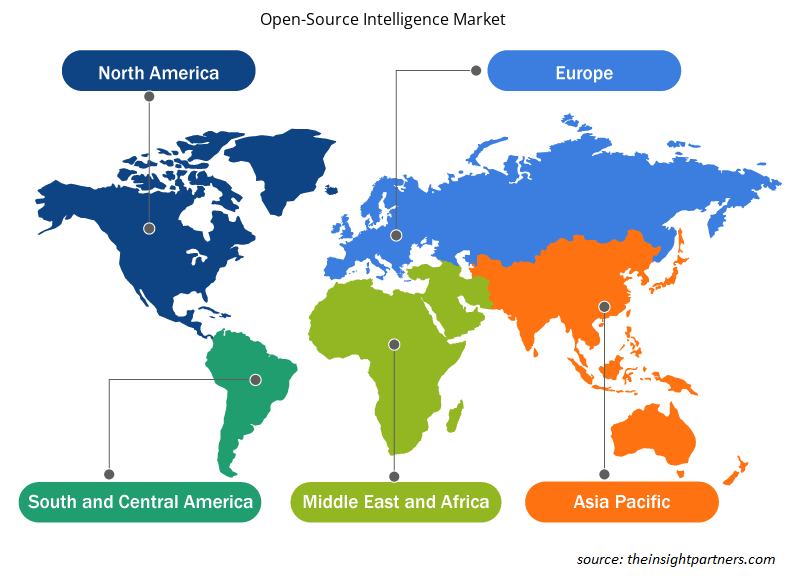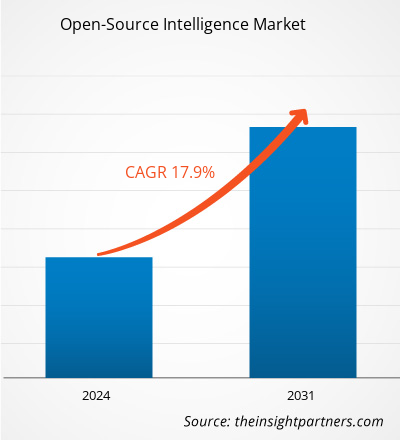オープンソース インテリジェンス市場規模は、2023 年の 47 億 5,000 万米ドルから 2031 年には 177 億 5,000 万米ドルに達すると予測されています。市場は 2023 年から 2031 年にかけて 17.9% の CAGR を記録すると予想されています。ソーシャル メディア インテリジェンスとリアルタイム分析は、今後も市場の主要なトレンドであり続けると思われます。
オープンソースインテリジェンス市場分析
特定のインテリジェンスクエリに対応するために公開されているデータを収集、評価、分析して得られるインテリジェンスは、オープンソースインテリジェンス(OSINT)として知られています。サイバーセキュリティツールとして、OSINTはセキュリティの脅威を評価し、ITインフラストラクチャの穴を見つけるために企業で広く使用されています。ハッカーやサイバー犯罪者も、フィッシング、ソーシャルエンジニアリング、サイバー攻撃の潜在的なターゲットを明らかにするためにOSINT技術を使用しています。サイバーセキュリティ以外にも、オープンソースインテリジェンスは、法執行、マーケティング、国家安全保障、メディア、学術研究などの分野でも使用される可能性があります。
オープンソースインテリジェンス市場の概要
近年、国家安全保障と社会全体に対する危険として、偽情報と誤情報のキャンペーンが注目を集めています。過去数年間、誤解を招く情報の拡散を許すほどの政治的不安が続いた結果、これらのリスクは変化しました。その結果、偽情報と偽情報対策を取り巻くエコシステムはより専門的になりました。そのため、オープンソース インテリジェンス市場の需要が高まっています。
要件に合わせてレポートをカスタマイズする
このレポートの一部、国レベルの分析、Excelデータパックなど、あらゆるレポートを無料でカスタマイズできます。また、スタートアップや大学向けのお得なオファーや割引もご利用いただけます。
- このレポートの主要な市場動向を入手してください。この無料サンプルには、市場動向から見積もりや予測に至るまでのデータ分析が含まれます。
オープンソースインテリジェンス市場の推進要因と機会
オープンソースインテリジェンスソリューションのコスト効率が市場を有利にする
他の形式の情報収集と比較すると、OSINT は一般の人が容易に入手できる情報に集中するため、コストが低く抑えられます。さらに、オープンソース情報の収集に必要なすべてのソフトウェアとツールは、主に一般の人々に適正な価格で提供されるため、はるかに実現可能です。その結果、OSINT はあらゆる形態や規模の企業にとって重要なリソースとなります。他の種類の情報を強化することで、OSINT はより確立された企業がデジタル フットプリント、脆弱性、脅威をより意識するのに役立ちます。
OSINTを支援する人工知能と機械学習(AI / ML)の活用
OSINT 技術が発展するにつれ、OSINT 研究をサポートするために AI と ML を使用することを提案する人が増えています。公開レポートによると、人工知能はすでに諜報機関や政府機関によってソーシャル メディア データの収集と処理に使用されています。AI と ML は、ソーシャル メディア プラットフォーム上の組織的なサイバー犯罪、虚偽のプロパガンダ、テロ、その他の国家安全保障上の脅威を検出し、対抗するために軍事グループによって使用されています。
オープンソースインテリジェンス市場レポートセグメンテーション分析
オープンソース インテリジェンス市場分析の導出に貢献した主要なセグメントは、技術とエンド ユーザーです。
- オープンソースインテリジェンス市場は、技術に基づいて、テキスト分析、ビデオ分析、ソーシャルメディア分析、地理空間分析、セキュリティ分析、その他に分類されます。セキュリティ分析セグメントは、2023年に最大のシェアを占めました。
- エンドユーザーに基づいて、市場は政府情報機関、軍事および防衛情報機関、サイバーセキュリティ組織、法執行機関、民間の専門企業、金融サービス、その他に分類されます。
オープンソースインテリジェンスの地域別市場シェア分析
オープンソース インテリジェンス市場レポートの地理的範囲は、主に北米、アジア太平洋、ヨーロッパ、中東およびアフリカ、南米および中米の 5 つの地域に分かれています。
北米は、2023年にオープンソースインテリジェンス市場の大きなシェアを占めます。米国やカナダなどの国には、OSINTなどのソリューションを育成・開発するための優れたITインフラストラクチャがあります。さらに、これらの国は防衛および軍事部門に多額のデジタル化予算を投じており、それがこの地域の需要を牽引しています。
オープンソースインテリジェンス市場地域分析
予測期間を通じてオープンソース インテリジェンス市場に影響を与える地域的な傾向と要因は、Insight Partners のアナリストによって徹底的に説明されています。このセクションでは、北米、ヨーロッパ、アジア太平洋、中東およびアフリカ、南米および中米にわたるオープンソース インテリジェンス市場のセグメントと地理についても説明します。

- オープンソースインテリジェンス市場の地域別データを入手
オープンソースインテリジェンス市場レポートの範囲
| レポート属性 | 詳細 |
|---|---|
| 2023年の市場規模 | 47億5千万米ドル |
| 2031年までの市場規模 | 177.5億米ドル |
| 世界のCAGR(2023年~2031年) | 17.9% |
| 履歴データ | 2021-2022 |
| 予測期間 | 2024-2031 |
| 対象セグメント | テクニック別
|
| 対象地域と国 | 北米
|
| 市場リーダーと主要企業プロフィール |
|
オープンソースインテリジェンス市場のプレーヤー密度:ビジネスダイナミクスへの影響を理解する
オープンソース インテリジェンス市場は、消費者の嗜好の変化、技術の進歩、製品の利点に対する認識の高まりなどの要因により、エンド ユーザーの需要が高まり、急速に成長しています。需要が高まるにつれて、企業は提供内容を拡大し、消費者のニーズを満たすために革新を起こし、新たなトレンドを活用し、市場の成長をさらに促進しています。
市場プレーヤー密度とは、特定の市場または業界内で活動している企業または会社の分布を指します。これは、特定の市場スペースに、その規模または総市場価値と比較して、どれだけの競合相手 (市場プレーヤー) が存在するかを示します。
オープンソース インテリジェンス市場で活動している主要企業は次のとおりです。
- ハイランドソフトウェア株式会社
- セルブライト
- エキスパートシステム SpA
- グーグル
- マルテゴテクノロジーズ
- ネットセントリーズテクノロジーズ FZCO
免責事項:上記の企業は、特定の順序でランク付けされていません。

- オープンソースインテリジェンス市場のトップキープレーヤーの概要を入手
オープンソースインテリジェンス市場のニュースと最近の動向
オープンソース インテリジェンス市場は、主要な企業出版物、協会データ、データベースなど、一次調査および二次調査後の定性的および定量的データを収集することによって評価されます。オープンソース インテリジェンス市場におけるいくつかの開発を次に示します。
- オープンソースインテリジェンス企業 Digital Clues AG (以下「Digital Clues」) は、公共および民間セクター向けデジタルインテリジェンス (DI) ソリューションのリーダーである Cellebrite (Nasdaq: CLBT) に資産を売却する正式契約を締結しました。この買収により、Cellebrite は法執行機関のインテリジェンスおよび捜査部門における世界的なプレゼンスを拡大し、業界をリードする同社のデジタルインテリジェンスプラットフォームを強化し、捜査ワークフロー全体をデジタル化できるエンドツーエンドのテクノロジーパートナーとしての地位を固めることが期待されます。(出典: Cellebrite、プレスリリース、2021 年 10 月)
- Maltego Technologies は、既存および新規のユーザーにさらに多くの調査機能、データ、およびサービスを提供するために、Maltego Professional および Organization プランを正式に導入しました。(出典: Maltego Technologies、プレスリリース、2024 年 5 月)
オープンソースインテリジェンス市場レポートの対象範囲と成果物
「オープンソースインテリジェンス市場の規模と予測(2021〜2031年)」レポートでは、以下の分野をカバーする市場の詳細な分析を提供しています。
- オープンソースインテリジェンス市場の規模と予測(対象範囲に含まれるすべての主要市場セグメントについて、世界、地域、国レベルで)
- オープンソースインテリジェンス市場の動向、および推進要因、制約、主要な機会などの市場動向
- 詳細なPEST/ポーターの5つの力とSWOT分析
- 主要な市場動向、世界および地域の枠組み、主要プレーヤー、規制、最近の市場動向を網羅したオープンソースのインテリジェンス市場分析
- 市場集中、ヒートマップ分析、主要プレーヤー、オープンソースインテリジェンス市場の最近の動向を網羅した業界展望と競争分析
- 詳細な企業プロフィール
- 過去2年間の分析、基準年、CAGRによる予測(7年間)
- PEST分析とSWOT分析
- 市場規模価値/数量 - 世界、地域、国
- 業界と競争環境
- Excel データセット



Report Coverage
Revenue forecast, Company Analysis, Industry landscape, Growth factors, and Trends

Segment Covered
This text is related
to segments covered.

Regional Scope
North America, Europe, Asia Pacific, Middle East & Africa, South & Central America

Country Scope
This text is related
to country scope.
よくある質問
North America dominated the open-source intelligence market in 2023.
The cost-effectiveness of open-source intelligence solutions and government regulations are expected to drive the open-source intelligence market.
Social media intelligence and real-time analytics are likely to remain key trends in the market.
Hyland Software, Inc., Cellebrite, Expert System S.p.A., Google LLC, Maltego Technologies, NetSentries Technologies FZCO, IPS S.p.A., Palantir Technologies, Recorded Future, Inc., Thales Group, and Siemens AG are among the leading payers operating in the open-source intelligence market.
The open-source intelligence market size is projected to reach US$ 17.75 billion by 2031
The open-source intelligence market is expected to register a CAGR of 17.9% during 2023–2031
Trends and growth analysis reports related to Technology, Media and Telecommunications : READ MORE..
The Insight Partners performs research in 4 major stages: Data Collection & Secondary Research, Primary Research, Data Analysis and Data Triangulation & Final Review.
- Data Collection and Secondary Research:
As a market research and consulting firm operating from a decade, we have published and advised several client across the globe. First step for any study will start with an assessment of currently available data and insights from existing reports. Further, historical and current market information is collected from Investor Presentations, Annual Reports, SEC Filings, etc., and other information related to company’s performance and market positioning are gathered from Paid Databases (Factiva, Hoovers, and Reuters) and various other publications available in public domain.
Several associations trade associates, technical forums, institutes, societies and organization are accessed to gain technical as well as market related insights through their publications such as research papers, blogs and press releases related to the studies are referred to get cues about the market. Further, white papers, journals, magazines, and other news articles published in last 3 years are scrutinized and analyzed to understand the current market trends.
- Primary Research:
The primarily interview analysis comprise of data obtained from industry participants interview and answers to survey questions gathered by in-house primary team.
For primary research, interviews are conducted with industry experts/CEOs/Marketing Managers/VPs/Subject Matter Experts from both demand and supply side to get a 360-degree view of the market. The primary team conducts several interviews based on the complexity of the markets to understand the various market trends and dynamics which makes research more credible and precise.
A typical research interview fulfils the following functions:
- Provides first-hand information on the market size, market trends, growth trends, competitive landscape, and outlook
- Validates and strengthens in-house secondary research findings
- Develops the analysis team’s expertise and market understanding
Primary research involves email interactions and telephone interviews for each market, category, segment, and sub-segment across geographies. The participants who typically take part in such a process include, but are not limited to:
- Industry participants: VPs, business development managers, market intelligence managers and national sales managers
- Outside experts: Valuation experts, research analysts and key opinion leaders specializing in the electronics and semiconductor industry.
Below is the breakup of our primary respondents by company, designation, and region:

Once we receive the confirmation from primary research sources or primary respondents, we finalize the base year market estimation and forecast the data as per the macroeconomic and microeconomic factors assessed during data collection.
- Data Analysis:
Once data is validated through both secondary as well as primary respondents, we finalize the market estimations by hypothesis formulation and factor analysis at regional and country level.
- Macro-Economic Factor Analysis:
We analyse macroeconomic indicators such the gross domestic product (GDP), increase in the demand for goods and services across industries, technological advancement, regional economic growth, governmental policies, the influence of COVID-19, PEST analysis, and other aspects. This analysis aids in setting benchmarks for various nations/regions and approximating market splits. Additionally, the general trend of the aforementioned components aid in determining the market's development possibilities.
- Country Level Data:
Various factors that are especially aligned to the country are taken into account to determine the market size for a certain area and country, including the presence of vendors, such as headquarters and offices, the country's GDP, demand patterns, and industry growth. To comprehend the market dynamics for the nation, a number of growth variables, inhibitors, application areas, and current market trends are researched. The aforementioned elements aid in determining the country's overall market's growth potential.
- Company Profile:
The “Table of Contents” is formulated by listing and analyzing more than 25 - 30 companies operating in the market ecosystem across geographies. However, we profile only 10 companies as a standard practice in our syndicate reports. These 10 companies comprise leading, emerging, and regional players. Nonetheless, our analysis is not restricted to the 10 listed companies, we also analyze other companies present in the market to develop a holistic view and understand the prevailing trends. The “Company Profiles” section in the report covers key facts, business description, products & services, financial information, SWOT analysis, and key developments. The financial information presented is extracted from the annual reports and official documents of the publicly listed companies. Upon collecting the information for the sections of respective companies, we verify them via various primary sources and then compile the data in respective company profiles. The company level information helps us in deriving the base number as well as in forecasting the market size.
- Developing Base Number:
Aggregation of sales statistics (2020-2022) and macro-economic factor, and other secondary and primary research insights are utilized to arrive at base number and related market shares for 2022. The data gaps are identified in this step and relevant market data is analyzed, collected from paid primary interviews or databases. On finalizing the base year market size, forecasts are developed on the basis of macro-economic, industry and market growth factors and company level analysis.
- Data Triangulation and Final Review:
The market findings and base year market size calculations are validated from supply as well as demand side. Demand side validations are based on macro-economic factor analysis and benchmarks for respective regions and countries. In case of supply side validations, revenues of major companies are estimated (in case not available) based on industry benchmark, approximate number of employees, product portfolio, and primary interviews revenues are gathered. Further revenue from target product/service segment is assessed to avoid overshooting of market statistics. In case of heavy deviations between supply and demand side values, all thes steps are repeated to achieve synchronization.
We follow an iterative model, wherein we share our research findings with Subject Matter Experts (SME’s) and Key Opinion Leaders (KOLs) until consensus view of the market is not formulated – this model negates any drastic deviation in the opinions of experts. Only validated and universally acceptable research findings are quoted in our reports.
We have important check points that we use to validate our research findings – which we call – data triangulation, where we validate the information, we generate from secondary sources with primary interviews and then we re-validate with our internal data bases and Subject matter experts. This comprehensive model enables us to deliver high quality, reliable data in shortest possible time.


 このレポートの無料サンプルを入手する
このレポートの無料サンプルを入手する